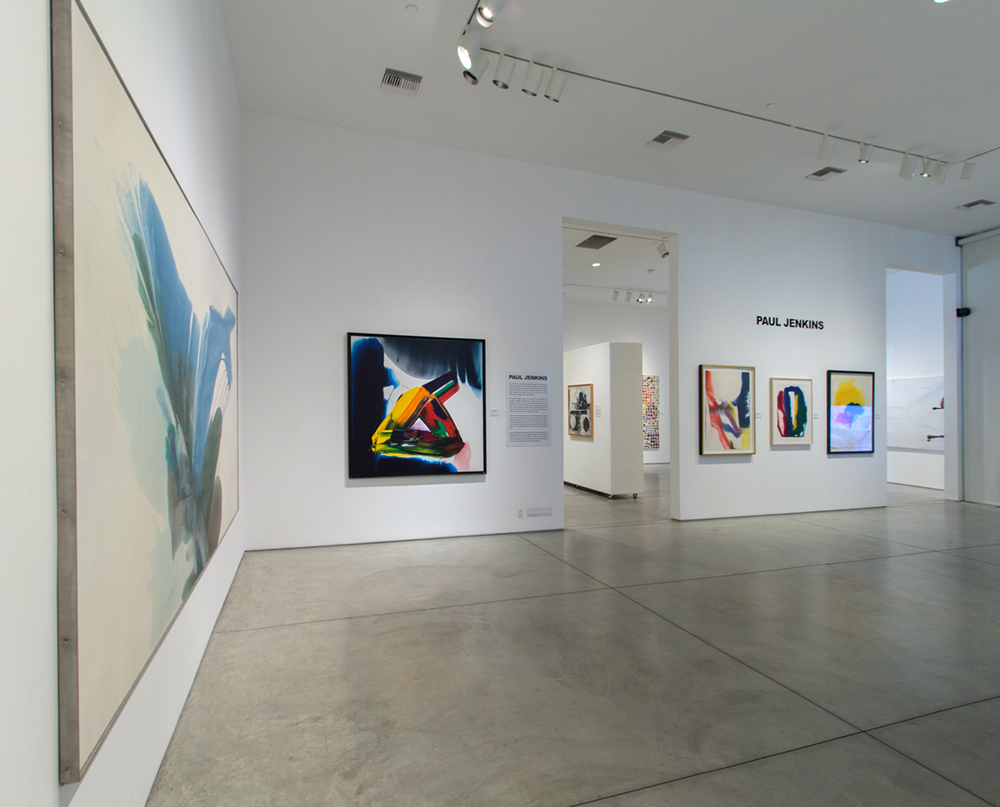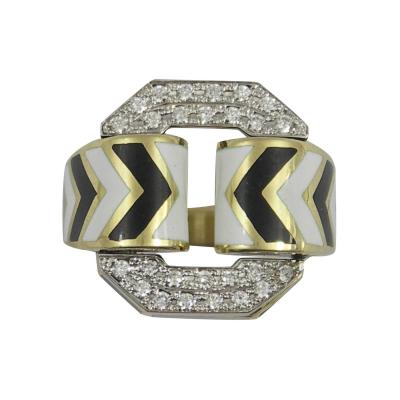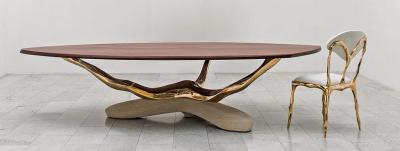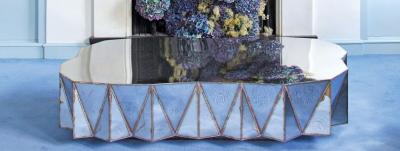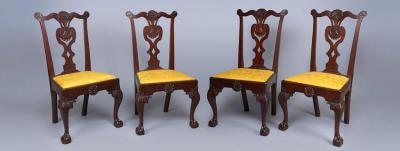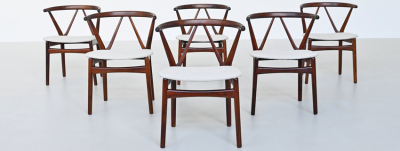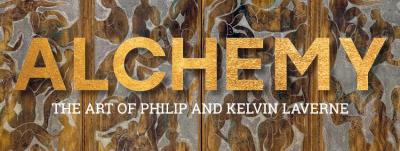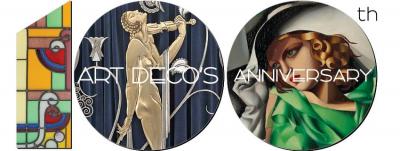This Week's Major Events: Tiffany Lamps & The Antiquarian Book Fair in NY, AD20/21 in Boston, Plus Major Modern Art Shows
APRIL 5-11
NEW YORK
A Passion for Tiffany Lamps, Queens Museum, Queens, NY
April 10, 2016-April 30, 2018
The Queens Museum is paying homage to the seminal Tiffany collectors Dr. Egon Neustadt and his wife, Hildegard with the exhibition A Passion for Tiffany Lamps. The couple, who were Austrian immigrants, purchased their first Tiffany lamp in New York in 1935, when demand for the work was very low. The Neustadts disregarded public opinion, which deemed Tiffany’s work unfashionable, and became fervent collectors. Over the next fifty years, the Neustadts collected over 200 lamps—the largest and most comprehensive lamp collection ever assembled—and helped revive public interest in Tiffany lamps. The exhibition at the Queens Museum, which houses a portion of the Neustadt Tiffany collection, includes iconic Tiffany forms as well as rare lamps that were not widely produced. Click here to continue reading.
New York Antiquarian Book Fair, Park Avenue Armory, New York, NY
April 7-10, 2016
The New York Antiquarian Book Fair will open with a preview party at the historic Park Avenue Armory on Thursday, April 7. Now in its 56th year, the fair will feature 200 dealers from the United States and abroad, offering everything from rare books and maps to manuscripts, illuminated manuscripts and ephemera. Produced by Sanford L. Smith + Associates, the fair is officially sanctioned by the Antiquarian Booksellers' Association of America and the International League of Antiquarian Booksellers. Highlights include a signed book of drawings by Jean-Michel Basquiat offered by Kenneth Mallory Books; a copy of Illustrations for the Bible by Marc Chagall offered by Manhattan Rare Book Company; and a rare edition of Lewis Carroll’s Alice in Wonderland with engravings by Alicia Scavino offered by Priscilla Juvelis, Inc. Click here to continue reading.
CALIFORNIA
Paul Jenkins, Heather James Fine Art, Palm Desert, CA
On view through May 1, 2016
Heather James Fine Art is currently hosting an exhibition of paintings by Paul Jenkins. Jenkins, who rose to prominence in the 1950s, created elegant, ethereal works using unorthodox techniques that relied on his absolute control of the paint. Although he was regarded as part of the Abstract Expressionist movement in New York, Jenkins’ use of color and flow distinguished him from his peers. The show at Heather James Fine Art features a number of notable works, including an untitled painting that previously adorned the walls of the John Lautner-designed Elrod House, a mid century architectural gem in Palm Springs. This painting makes an appearance in the 1971 James Bond film, Diamonds are Forever, which was filmed in the Elrod House. Click here to continue reading.
MASSACHUSETTS
The Idea of North: The Paintings of Lawren Harris, Museum of Fine Arts, Boston, MA
On view through June 12, 2016
Fun fact: this exhibition—the first in the United States to explore the work of the Canadian Modernist Lawren Harris—was curated by the celebrated comedian Steve Martin. Although he is largely unknown stateside, Harris played a pivotal role in defining Canadian art during the twentieth century. The Idea of North, which has been organized by the Hammer Museum in Los Angeles and the Art Gallery of Ontario in Toronto, presents approximately thirty paintings that exemplify Harris’ idealized northern landscapes from the 1920s and 1930s—one of the most significant periods of the artist’s career. Crisp, sparse and commanding, Harris’ depictions of Canada remain, for many, quintessential images of the Great White North. Click here to continue reading.
AD20/21: Art & Design of the 20th & 21st Centuries, The Cyclorama at the Boston Center for the Arts, Boston, MA
April 7-10, 2016
AD20/21, the only show of its kind in New England, features fifty exhibitors offering modern to contemporary fine art, mid century and contemporary studio furniture, jewelry, decorative arts, and sculpture. Among the must-see dealers at AD20/21 are Glen Leroux Antiques, Habatat Galleries, and Moderne Gallery. The show will be complemented by the Boston Print Fair (also held at The Cyclorama), which features fine print galleries, contemporary print publishers, photography, drawings, and other works on paper. AD20/21 will open with a gala preview on April 7, during which the Boston Globe’s retired antiques columnist, Virginia Bohlin, will receive a lifetime achievement award. Click here to continue reading.
CONNECTICUT

- Parlor chair, c. 1863, American, probably Boston, Rosewood and silk damask, Wadsworth Atheneum Museum of Art, Gift of Mrs. Horace B. Clark and Thomas L. Cox, by exchange, 1985.2.2; Dress with evening bodice, c. 1850, American, Silk, Wadsworth Atheneum Museum of Art, Gift of the Estate of Matta Grimm Lacey, 1976.33B,C; Chantilly lace shawl, c. 1850-75, French, Silk, Wadsworth Atheneum Museum of Art, Gift of Mr. and Mrs. Kraatz, Paris, 1984.70.
Gothic to Goth: Romantic Era Fashion & Its Legacy, Wadsworth Atheneum, Hartford, CT
On view through July 10, 2016
This fascinating exhibition at the Wadsworth Atheneum, which reopened after a massive renovation last fall, is the first show dedicated to the Romantic era as a formative period in costume history. Much like art, design, literature and music from the early-nineteenth century, fashion of the era reflected a shift away from a logic-centered way of thinking to a more emotion-based mindset. During this period, clothing tended to be highly decorative—full skirts, embellished sleeves and hems, ruffles, and fine fabrics, including gauze, silk and lace, reigned supreme. Gothic to Goth features stunning historic garments alongside literary works, paintings, prints, and decorative arts, and examines how European fashions from the Medieval, Renaissance, and Baroque eras influenced and inspired new styles created between 1810 and 1860. The show also highlights more recent fashions influenced by the Romantic era, including goth and steampunk—both of which are meant to reflect one's individuality and emotions. Click here to continue reading.
PENNSYLVANIA
Breaking Ground: Printmaking in the US, 1940-1960, Philadelphia Museum of Art, Philadelphia, PA
On view through July 24, 2016
This exhibition at the Philadelphia Museum of Art focuses on printmaking in the 1940s and 1950s—a pivotal period for the centuries old medium. Drawn entirely from the institution’s own holdings, Breaking Ground presents prints, ceramics, sculpture and textiles by such luminaries as Anni Albers, Antonio Frasconi, Stanley William Hayter, Alice Trumbull Mason, Gabor Peterdi, Robert Rauschenberg, and June Wayne. The evolution of modern printmaking began in the 1940s with the popularization of such techniques as screenprinting and color lithography as well as the revival of traditional mediums such as the color woodcut. From there, interest in printmaking skyrocketed. As workshops filled with experimental and innovative artists sprouted up across the country, the medium was taken to unprecedented heights. Click here to continue reading.
Philadelphia Invitational Furniture Show, 23rd Street Armory, Philadelphia, PA
April 8-10, 2016
The Philadelphia Furniture Show, held April 8-10 at the 23rd Street Armory, is dedicated to supporting the city’s tradition of fine woodworking as well as the proliferation of craftspeople nationwide. Now in its 22nd year, the show, which highlights exceptional artisan-quality furniture, is the longest running exhibition of its kind. This year’s show will feature the work of seventy-five artisans, including woodworkers, weavers, potters and photographers. Exhibitors include the Nakashima Foundation for Peace; Greg Pilotti, a Chester County furniture maker whose works are inspired by the craftspeople of the 17th, 18th and 19th centuries; and John Landis, a Pennsylvania-based furniture maker who creates architectural pieces in exotic woods. Click here to continue reading.
OHIO
Converging Lines: Eva Hesse and Sol Lewitt, Cleveland Museum of Art, Cleveland, OH
On view through July 31, 2016
Sol Lewitt and Eva Hesse met in New York City in the late 1950s and forged what would become a decade-long friendship. This exhibition, organized by the Blanton Museum of Art in Austin, Texas, explores the bond these artists shared and the profound effect that it had on their work and their lives, despite their seemingly disparate practices. This indelible influence is beautifully apparent in Lewitt’s Wall Drawing #46, which was created immediately upon learning of Hesse’s premature death in 1970 at the age of thirty-four. Rather than using his typical straight lines, Lewitt utilized more organic forms—an homage to Hesse’s biomorphic work. Converging Lines presents approximately fifty works, many of which have not been publicly displayed in decades. Click here to continue reading.
MINNESOTA

- Sigmar Polke, Frau Herbst und ihre zwei Töchter (Mrs. Autumn and Her Two Daughters), 1991 artificial resin, acrylic on synthetic fabric 118 × 196.75 × 1.625 inches unframed Collection Walker Art Center, Minneapolis, Gift of Ann and Barrie Birks, Joan and Gary Capen, Judy and Kenneth Dayton, Joanne and Philip Von Blon, Penny and Mike Winton, with additional funds from the T. B. Walker Acquisition Fund, 1991.
Less Than One, Walker Art Center, Minneapolis, MN
April 7-December 31, 2016
This sweeping exhibition, which spans from the 1960s to the present, highlights sixteen artists central to the Walker Art Center’s permanent collection, including Jasper Johns, Joan Jonas, Sigmar Polke, Dieter Roth, and Kara Walker. Representing a range of media and movements, Less Than One reflects the considerable diversity among the institution's holdings, which include paintings, sculptures, drawings, installations, videos, performance art, and photography. Among the highlight are the iconic Polke painting Mrs. Autumn and Her Two Daughters (1991) and a number of recent acquisitions by such artists as Ericka Beckman, Adrian Piper, and Renée Green. Click here to continue reading.
VIRGINIA
A Century of African American Quilts, Colonial Williamsburg, Williamsburg, VA
On view through May 2018
The exhibition features twelve quilts made after the abolition of slavery, six of which have never before been exhibited. The quilts display a freedom from convention that sets these examples apart from those made using ordinary appliqué and piecing techniques. Depending on the location of the quilter, the purpose for which the quilt was made, and the quilter’s personal artistic vision, these African- American-made covers varied widely. Some of the women who made the quilts adapted patterns or were inspired by their Anglo-American neighbors. Others appear to have been guided by their own artistic vision, informed and influenced by their African heritage. An especially unique regional group from the twentieth century represented in the exhibition is from the Gee’s Bend, Alabama, vicinity. These quilts are renowned for their innovative use of color, pattern, asymmetry and the free adaptation of traditional quilt designs. Click here to continue reading.
TEXAS
The Precarious, The Menil Collection, Houston, TX
On view through May 1, 2016
In addition to providing a bird’s eye view of the evolution of collage, which emerged in the early twentieth century, this exhibition explores the inherently precarious nature of the medium. Often comprised of found objects, hand-cut paper and the artist’s own marks, these layered works are fragile and often, seemingly ephemeral. Bookended by works by Kurt Schwitters, who is widely considered the twentieth century’s greatest collage artist, and the contemporary artist Danh Vo, this exhibition includes pieces by a number of important post-war figures, including Cy Twombly, John Chamberlain, Ellsworth Kelly, Claes Oldenburg, Elizabeth McFadden, Robert Rauschenberg, Anne Ryan, and Richard Tuttle. Click here to continue reading.
















